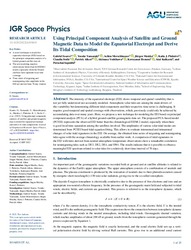Using Principal Component Analysis of Satellite and Ground Magnetic Data to Model the Equatorial Electrojet and Derive Its Tidal Composition
Pinheiro, Katia J.
Kulkarni, Atul
Supnithi, Pornchai
DOI: https://doi.org/10.1029/2022JA030691
Persistent URL: http://resolver.sub.uni-goettingen.de/purl?gldocs-11858/10441
Persistent URL: http://resolver.sub.uni-goettingen.de/purl?gldocs-11858/10441
Soares, Gabriel; Yamazaki, Yosuke; Morschhauser, Achim; Matzka, Jürgen; Pinheiro, Katia J.; Stolle, Claudia; Alken, Patrick; Yoshikawa, Akimasa; Hozumi, Kornyanat; Kulkarni, Atul; Supnithi, Pornchai, 2022: Using Principal Component Analysis of Satellite and Ground Magnetic Data to Model the Equatorial Electrojet and Derive Its Tidal Composition. In: Journal of Geophysical Research: Space Physics, Band 127, 9, DOI: 10.1029/2022JA030691.
 |
Dokument öffnen: |
The intensity of the equatorial electrojet (EEJ) shows temporal and spatial variability that is not yet fully understood nor accurately modeled. Atmospheric solar tides are among the main drivers of this variability but determining different tidal components and their respective time series is challenging. It requires good temporal and spatial coverage with observations, which, previously could only be achieved by accumulating data over many years. Here, we propose a new technique for modeling the EEJ based on principal component analysis (PCA) of a hybrid ground‐satellite geomagnetic data set. The proposed PCA‐based model (PCEEJ) represents the observed EEJ better than the climatological EEJM‐2 model, especially when there is good local time separation among the satellites involved. The amplitudes of various solar tidal modes are determined from PCEEJ based tidal equation fitting. This allows to evaluate interannual and intraannual changes of solar tidal signatures in the EEJ. On average, the obtained time series of migrating and nonmigrating tides agree with the average climatology available from earlier work. A comparison of tidal signatures in the EEJ with tides derived from neutral atmosphere temperature observations show a remarkable correlation for nonmigrating tides such as DE3, DE2, DE4, and SW4. The results indicate that it is possible to obtain a meaningful EEJ spectrum related to solar tides for a relatively short time interval of 70 days. Key Points:
A novel technique to model the equatorial electrojet (EEJ) based on the principal component analysis of a hybrid ground‐satellite data set.
The new modeling matches observations better than the EEJM‐2 model, especially when the Swarm satellites have optimum local time coverage.
Time series of migrating and nonmigrating tides amplitude in the EEJ are derived from 70‐day window.
Statistik:
ZugriffsstatistikSammlung:
This is an open access article under the terms of the Creative Commons Attribution License, which permits use, distribution and reproduction in any medium, provided the original work is properly cited.

